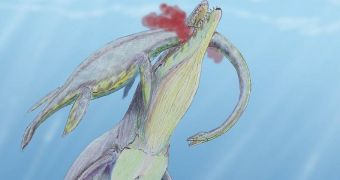According to the conclusions of a new scientific study, it would appear that the asteroid that hit Earth at the end of the Cretaceous Era, some 65.5 million years ago, turned the world's oceans into a stew of sulfuric acid. This contributed significantly to the annihilation of a large percentage of all marine species living on our planet at the time.
The Cretaceous-Paleogene (K-T) extinction event is responsible for wiping out all dinosaurs in the air, water, and on the ground. This paved the way for the development of larger mammals, which eventually took over the world. Until the K-T event, the average size of mammals did not exceed that of a rabbit.
Scientists have been trying to understand what exactly happened during this extinction event. While most experts agree that an asteroid impact is the most likely major cause of the natural disaster, the specifics of what happened remain mysterious. The role that ocean chemistry played in annihilating marine species has not been studied in-depth until now.
The K-T event, while tamer than the Great Dying (the Permian-Triassic extinction that took place 252.2 million years ago), still ranks as one of the five largest such events in Earth's history. It is currently estimated that as many as 80 percent of all species living on our planet were destroyed when the asteroid struck, or shortly afterwards.
These species included almost all creatures living in the upper layers of the world's oceans, as well as those in lakes and rivers. This occurred through extreme exposure to sulfur trioxide, a chemical rich in sulfates that was produced in vast amounts following the vaporization of anhydrite marine rocks. The asteroid that triggered the extinction fell off the Yucatán Peninsula, in Mexico.
The new investigation was led by researchers at the Chiba Institute of Technology in Japan, who were coordinated by expert Sohsuke Ohno, the lead author of the research paper. The work is detailed in the March 9 issue of the top journal Nature Geoscience.
“Our experimental results indicate that sulfur trioxide is expected to be the major sulfide component in the sulfur oxide gas released during the impact. In addition to that, by the scavenging or sweeping out of acid aerosols by coexisting silicate particles, sulfuric acid would have settled to the ground surface within a very short time,” Ohno explains, quoted by Space.
The research provides an elegant explanation for why marine species living deep under the ocean surface were largely unaffected by the K-T event. The acid rain that brought sulfur trioxide to the upper layers of the oceans were unable to deliver enough chemicals to contaminate the deep ocean as well.

 14 DAY TRIAL //
14 DAY TRIAL //